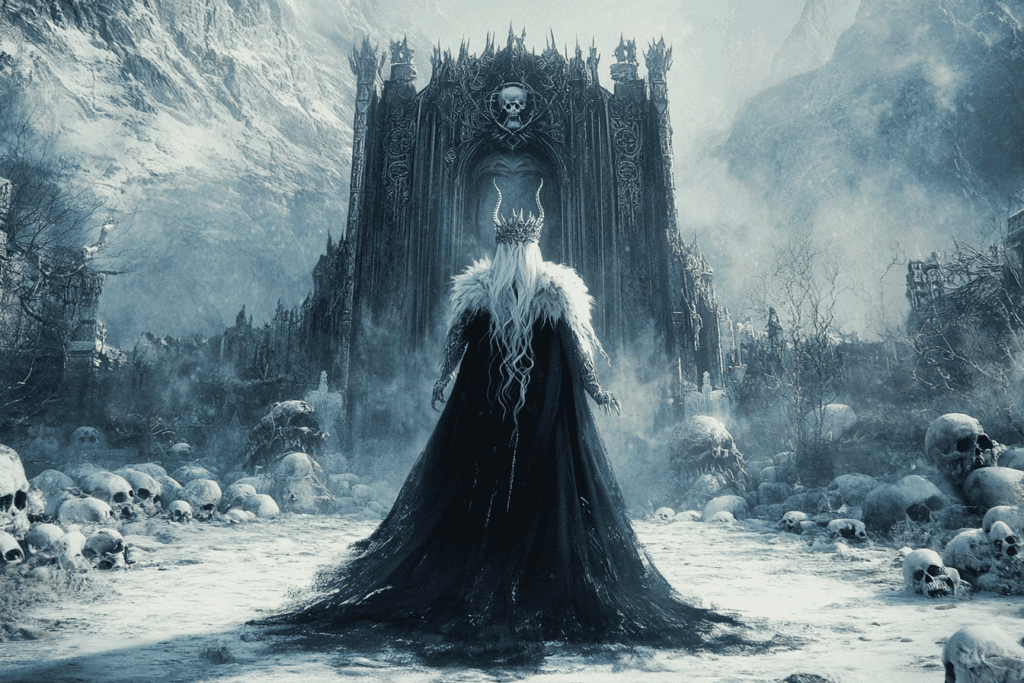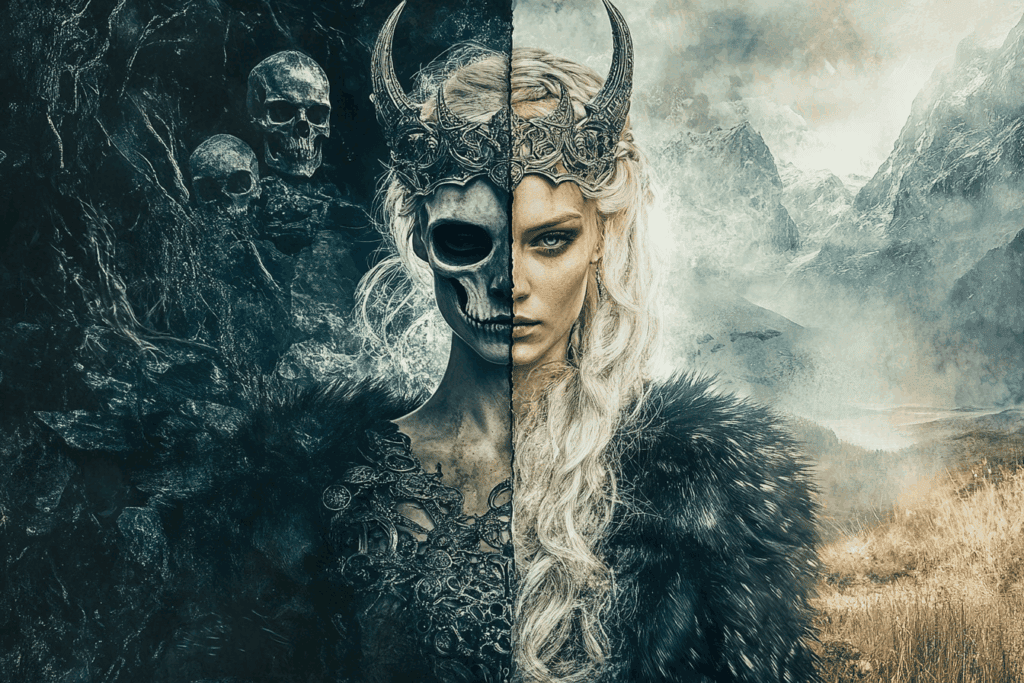In Norse mythology, few figures evoke as much mystery and reflection as Hel, the goddess of the underworld.
Her presence in Old Norse literature stands at the threshold of life and death, governing a realm few dared to imagine yet all must one day face.
This article explores the symbols of Hel, her role in Norse mythology, and the Norse understanding of death and the afterlife.
Every detail shared here is grounded in academic sources and ethnohistorical scholarship.
The body of research based literature is vast and complex and the work that has been done on Norse mythology by prehistorians, archaeologists, ethnographers, folklorists and historians of religion deserves a lot of credit, attention and further exploration.

Table of Contents
Who is Hel in Norse Mythology?
Hel is the daughter of Loki and the giantess Angrboda. She rules over the realm of the dead, also named Hel.
Her realm lies beneath Yggdrasil, connected to one of its three roots—this cosmological placement underlines her domain’s otherworldly nature (Lindow, 2001, pp. 172–173).
Described with a “half black, half flesh-colored” body, her appearance symbolizes her duality: part decay, part life. Hel’s hall, Éljúðnir, is cold and grim—opposing the bright halls of gods like Odin or Freyja.
The dog Garm guards her gates (Lindow, 2001, pp. 172–173).
What Does Hel’s Appearance Symbolize?
Hel is often depicted with a body half alive and half dead. This dual image visually represents the boundary between life and death.
Her figure in Norse mythology captures the balance of life and death, symbolizing how both are inseparable in the Norse worldview.
Her divided form becomes a living symbol of the duality of existence. She is both the goddess of death and the goddess of the underworld, illustrating the profound symbolism of death and the afterlife.
What is the Norse Underworld Like?
The underworld in Norse belief was not a place of punishment. It was a destination, one of several realms in Norse cosmology.
Hel’s realm, Éljúðnir, was surrounded by high walls and a great gate—symbols of separation and sanctuary, not torment (Lindow, 2001, p. 172).
According to Hultgård (2011), Norse eschatology presented multiple afterlife destinations influenced by social role and ritual context.
Hel’s domain housed those who died of illness or old age, forming a necessary part of Norse cosmological order (Hultgård, 2011, pp. 298–301).
This shows the role of Hel in Norse mythology as the goddess of death in Norse tradition.

What Symbols are Associated with Hel?
Symbols associated with Hel include her half-living body, her hall Éljúðnir, the hound Garm, and the gates of Hel.
These symbols reinforce her role as guardian of the boundary between life and death.
Mist, cold, descent, and silence are also recurring motifs that express the liminal nature of her domain (Lindow, 2001, pp. 172–173; Hultgård, 2011).
These are essential hel symbols, used throughout ancient Norse literature to define her presence in the realm of the dead and the underworld.
What is Hel’s Role in Baldr’s Death?
In the myth of Baldr’s death, Hel plays a crucial role.
When Hermóðr travels to Hel to plead for Baldr’s return, she agrees to release him only if all beings in the world weep for him.
When one creature refuses, Baldr remains in the underworld. This positions Hel as a judge over fate and emotion (Lindow, 2001, p. 173).
This narrative highlights her role as the goddess of death and her powerful position within Norse mythology and its pantheon.

How Did the Norse View Death?
Pre-Christian Norse beliefs viewed death not as punishment but a continuation of existence.
Burial practices and mythic traditions suggest a pluralistic system where Hel’s realm was integral, especially for respected individuals who did not die in battle (Hultgård, 2011, pp. 298–299).
The Norse people accepted death as part of the cosmic cycle. Hel was a key figure in maintaining this order, embodying containment, transition, and cosmic necessity.
Hel in Norse mythology emphasizes death as a natural part of life.
Gender and the Norse Underworld
Scholar Judy Quinn from the University of Cambridge (2006) argues that Hel’s identity as a female deity in control of death challenges patriarchal expectations.
While gods like Odin govern battle glory, Hel’s feminine authority rules over the subdued dead.
Her cold, enclosed realm reflects both care and control, mirroring burial customs and female-associated continuity (Quinn, 2006, pp. 54–56).
This makes Hel not just a goddess, but the Norse goddess of death who governs a domain aligned with ancient Norse views of fate and femininity.

Hel and Norse Linguistic Roots
The word “Hel” is linguistically related across several Germanic languages, including Gothic “Halja” and Anglo-Saxon “Hellia,” meaning a concealed or lower place.
These linguistic roots reveal that Hel’s original meaning was not infernal but referential to the hidden world of the dead (Rydberg, 2003, pp. 276–278).
This old Norse word points to her function as the goddess of the underworld.
What is the Difference Between Hel and Niflhel?
Texts such as Vegtamskviða suggest a distinction between Hel and Niflhel.
While Hel houses the unheroic dead, Niflhel is reserved for those suffering a “second death”—possibly representing a deeper metaphysical layer of the Norse underworld (Rydberg, 2003, pp. 279–280).
This shows the layered conception of death in Norse mythology and the variety of beliefs within Norse cosmology.
Why is Hel a Vital Part of Norse Mythology?
Hel’s presence solidifies the Norse worldview’s cyclical understanding of life and death. Her realm provides necessary space for memory, rest, and fate.
As a ruler, her symbolism—mist, dogs, thresholds, and cold—communicates profound ideas about transition and social order (Hultgård, 2011).
She is the Norse goddess Hel, queen of the underworld, whose role in Norse mythology affirms that death is not an end, but a part of cosmic continuity.
STUDY GUIDE NOTES
- Hel rules over a vital realm of the Norse underworld, not a place of punishment.
- Her half-dead appearance symbolizes transition and duality.
- She governs death through symbols like Éljúðnir, Garm, mist, and gates.
- Hel plays a crucial role in the myth of Baldr’s death, enforcing rules with fairness.
- Her domain represents the necessary continuation of life after death.
- As a female figure, she symbolizes care, fate, and liminal transition.
References
Hultgård, A. (2011). Afterlife ideas among the ancient Scandinavians. In S. Steinsland, J. Rekdal, J. Meulengracht Sørensen, & I. Mundal (Eds.), Ideology and Power in the Viking and Middle Ages (pp. 298–301). Brill.
Lindow, J. (2001). Norse Mythology: A Guide to the Gods, Heroes, Rituals, and Beliefs. Oxford University Press.
Quinn, J. (2006). The gendering of death in eddic cosmology. In A. Andrén, K. Jennbert, & C. Raudvere (Eds.), Old Norse Religion in Long-Term Perspectives: Origins, Changes, and Interactions (pp. 54–56). Nordic Academic Press.
Rydberg, V. (2003). Teutonic Mythology: Gods and Goddesses of the Northland (G. H. Stephens, Trans.). Kessinger Publishing. (Original work published 1886)

